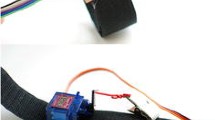Abstract
We suggest that novel playware technology can function as a mediator for playful social interaction over long distances, such as where people are separated by physical distance but feel the presence of each other mediated through their interaction with the playware technology. In order to investigate such social playware, we developed the Playware Soccer game and tested it with more than 1000 users during the FIFA World Cup 2010 in South Africa. The test was conducted in townships, orphanages for HIV/AIDS children, markets, FIFA fan parks, etc., along with simultaneous tests with similar set-ups in Europe and Asia. With the social playware, players would compete against each other simultaneously in three continents, Africa, Europe, and Asia, and feel the presence of the competitors on the other continents expressed through the playware. The playware game is set up to motivate players to engage in training in technical soccer skills by receiving immediate feedback and offering challenges to players of all skills at soccer. It is played on a modular interactive wall composed of modular interactive tiles that respond with colored lights, sounds, and scores of the players’ performance. This article outlines the concept of social playware and physical-virtual tele-play, and exemplifies this with the playware soccer game.
Similar content being viewed by others
Explore related subjects
Discover the latest articles, news and stories from top researchers in related subjects.References
Lund HH, Klitbo T, Jessen C (2005) Playware technology for physically activating play. Artif Life Robotics 9(4):165–174
Breazeal C (2002) Designing sociable robots. MIT Press, Cambridge
Fong T, Nourbakhsh I, Dautenhahn K (2003) A survey of socially interactive robots. Robotics Auton Syst 42(3–4):143–166
Billard A (2003) Robota: clever toy and educational tool. Robotics Auton Syst 42:259–269
Resnick M, Martin F, Berg R, et al (1998) Digital manipulatives: new toys to think with. Proceedings of the CHI’98 Conference on Human Factors in Computing Systems, Los Angeles, April, pp 281–287
Jessen C, Lund HH. On play forces, play dynamics and playware. Unpublished manuscript
Ishiguro H (2006) Android science: conscious and subconscious recognition. Connect Sci 18(4):319–332
Sakamoto D, Kanda T, Ono T, et al (2007) Androids as a telecommunication medium with human-like presence. Proceedings of the 2nd ACM/IEEE International Conference on Human-Robot Interactions
Mueller F, Agamanolis A, Picard R (2003) Exertion interfaces: sports over a distance for social bonding and fun. Proceedings of CHI 2003, ACM, 5:1, pp 561–568
Suzuki K. Hashimoto S (2004) FeelLight: a communication device for distant nonverbal exchange. Proceedings of ETP’04, New York, ACM
Lund HH (2009) Modular robotics for playful physiotherapy. Proceedings of the IEEE International Conference on Rehabilitation Robotics, IEEE Press, New York, pp 571–575
Lund HH, Marti P (2009) Designing modular robotic playware. 18th IEEE International Symposium on Robot and Human Interactive Communication (Ro-Man 2009), IEEE Press, New York, pp 115–121
Arkin RC (1998) Behavior-based robotics. MIT Press, Cambridge
Brooks RA (1986) A robust layered control system for a mobile robot. IEEE J Robotics Autom 2(1):14–23
Author information
Authors and Affiliations
Corresponding author
About this article
Cite this article
Lund, H.H., Thorsteinsson, T. Social playware for mediating tele-play interaction over distance. Artif Life Robotics 16, 435–440 (2012). https://doi.org/10.1007/s10015-011-0995-8
Received:
Accepted:
Published:
Issue Date:
DOI: https://doi.org/10.1007/s10015-011-0995-8




